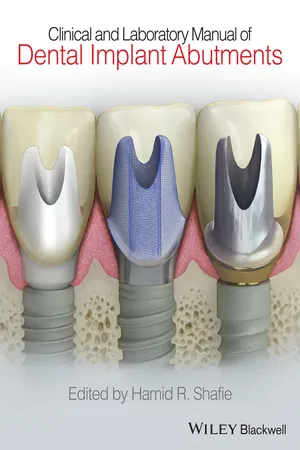
- English
- ePUB (mobile friendly)
- Available on iOS & Android
Clinical and Laboratory Manual of Dental Implant Abutments
About This Book
To fulfill the vision for his latest book, Dr. Hamid Shafie compiled technical information from a vast variety of sources, including implant manufacturers and designers, master dental technicians, implant researchers, and expert clinicians leading the field of implant dentistry worldwide. He and his expert contributors meticulously assembled each chapter to include only the most relevant and up-to-date content and procedures in a concise and simple format.
Dr. Shafie follows the same easy-to-read, easy-to-understand format as his best-selling textbook Clinical and Laboratory Manual of Implant Overdentures. Starting with the material science behind implant abutments, the text then describes all of the relevant abutment solutions, providing a step-by-step guide to design and manufacturing of the CAD/CAM abutments and explaining how to adjust prefabricated abutments and one-piece titanium and zirconia implants. In addition to offering the ultimate procedural guide for clinical and laboratory preparation of dental implant abutments, this textbook is filled with useful tips on clinical practice management such as sterilization, instrumentation and trouble-shooting related to implant abutments.
Clinical and Laboratory Manual of Dental Implant Abutments is the only text devoted exclusively to an in-depth look at implant abutments. Every dental implant clinician, technician, student, and implant industry insider needs this vital work in their library.
Frequently asked questions
Information
1
Implant Abutment Materials
Introduction
Mucosal Seal
Natural Dentition
Peri-implant Mucosal Seal

Pellicle, Biofilm, and Periodontal Disease
Pellicle
Biofilm
Periodontal Disease in the Natural Dentition
Peri-implantitis
Table of contents
- Cover
- Table of Contents
- Title page
- Copyright page
- List of Contributors
- Forewords
- Preface
- Dedications
- 1: Implant Abutment Materials
- 2: General Information about Implant Abutments
- 3: Retaining Abutment Screws
- 4: Different Implant–Abutment Connections
- 5: Prefabricated Implant Abutments
- 6: Use of CAD/CAM Technology in Custom Abutment Manufacturing
- 7: Relationship between Abutment Geometry and Peri-implant Tissue in Esthetic Zone Cases
- 8: Instrumentation for Abutment Modification and Guidelines for their Use
- 9: Abutment Preparation Techniques for One-Piece Titanium and Zirconia Implants
- 10: Cleaning, Disinfection, and Sterilization Techniques for Implant Abutments
- Index
- End User License Agreement